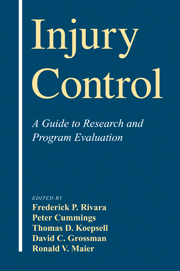Book contents
- Frontmatter
- Contents
- List of Contributors
- 1 An Overview of Injury Research
- 2 Classifying and Counting Injury
- 3 Measurement of Injury Severity and Co-morbidity
- 4 Data Linkages and Using Administrative and Secondary Databases
- 5 Rates, Rate Denominators, and Rate Comparisons
- 6 Data Collection Methods
- 7 Selecting a Study Design for Injury Research
- 8 Qualitative Methods in Injury Research
- 9 Randomized Trials
- 10 Cohort Studies in Injury Research
- 11 Case–Control Studies in Injury Research
- 12 Ecologic Studies
- 13 Case Series and Trauma Registries
- 14 Systematic Reviews of Injury Studies
- 15 Evaluating an Injury Intervention or Program
- 16 The Development of Clinical Decision Rules for Injury Care
- 17 Trauma Performance Improvement
- 18 Measuring Disability and Quality of Life Postinjury
- 19 Economic Evaluation of Injury Control
- 20 Ethical Issues
- Index
7 - Selecting a Study Design for Injury Research
Published online by Cambridge University Press: 16 October 2009
- Frontmatter
- Contents
- List of Contributors
- 1 An Overview of Injury Research
- 2 Classifying and Counting Injury
- 3 Measurement of Injury Severity and Co-morbidity
- 4 Data Linkages and Using Administrative and Secondary Databases
- 5 Rates, Rate Denominators, and Rate Comparisons
- 6 Data Collection Methods
- 7 Selecting a Study Design for Injury Research
- 8 Qualitative Methods in Injury Research
- 9 Randomized Trials
- 10 Cohort Studies in Injury Research
- 11 Case–Control Studies in Injury Research
- 12 Ecologic Studies
- 13 Case Series and Trauma Registries
- 14 Systematic Reviews of Injury Studies
- 15 Evaluating an Injury Intervention or Program
- 16 The Development of Clinical Decision Rules for Injury Care
- 17 Trauma Performance Improvement
- 18 Measuring Disability and Quality of Life Postinjury
- 19 Economic Evaluation of Injury Control
- 20 Ethical Issues
- Index
Summary
Introduction
The first step in conducting an injury-related research project is to specify the research question. The second step is to choose a study design.
What exactly is meant by a study design? In broad terms, it is a plan for identifying study subjects and for obtaining data on them. The study subjects are often people, but they can be other kinds of observation units, including social groups, physical settings, time periods, devices, published articles, and so on. Data on study subjects can come from pre-existing sources or can be gathered anew by a wide variety of methods ranging from ethnographic observation to questionnaires to specialized physiologic measurements. Many study designs involve comparing data between groups of study subjects or on the same subjects monitored over time.
The number of different study designs is potentially infinite, and they can be classified in many ways. The organizing scheme used here, shown in Figure 7.1, draws its terminology from epidemiology, biomedical research, and the social sciences. However, the underlying ideas are quite general, and this scheme can be usefully applied to a wide range of injury research. This chapter seeks to provide an overview of the major study designs, to highlight factors that guide the investigator to an appropriate design choice, and to illustrate the application of several commonly used study designs to injury research through examples.
Questions to Consider in Choosing a Design
Does the Primary Research Aim Involve
Description or Hypothesis Testing?
Some research merely seeks to characterize a prevailing state of affairs, without any advance prediction or expectation about what might be found.
Keywords
- Type
- Chapter
- Information
- Injury ControlA Guide to Research and Program Evaluation, pp. 89 - 103Publisher: Cambridge University PressPrint publication year: 2000



